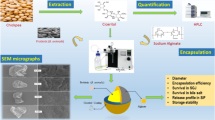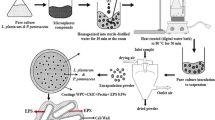Abstract
The main goal of this study was to develop an improved oral delivery system for Pediococcus pentosaceus OZF, a promising probiotic bacterium, and to assess its viability under simulated gastrointestinal (GI) tract model by comparing the efficiency of microbiological and molecular approaches. Encapsulation was carried out using extrusion method and as a result, encapsulation system including 0.75 % lactulose, 1.8 % sodium alginate, 0.1 M CaCl2, and 5 min gelling time was shown to have a significantly protective effect against pH 2.0 acid stress over 3 h. However, completely loss of viability was exhibited by free OZF cells under similar conditions. To provide an additional barrier for capsules, coating process was investigated using different biopolymers, and the survival rates of free and encapsulated OZF cells upon expose to simulated GI conditions were detected by conventional culture techniques and propidium monoazide-quantitative polymerase chain reaction (PMA-qPCR) method. No significant differences between the biopolymers were detected, except the chitosan which leads totally 85 % protection and extra 25 % improvement in the survival of OZF cells compared to uncoated capsules. In conclusion, our findings indicated that chitosan-coated capsules provided an important protective effect on the viability of OZF cells against the GI system conditions encountered during the transit of food. In addition, this study was found successful in monitoring the viable OZF cells in capsules using PMA-qPCR method.






Similar content being viewed by others
References
Aurelia P, Capurso L, Castellazzi AM, Clerici M, Giovannini M, Morelli L et al (2011) Probiotics and health: an evidence-based review. Pharmacol Res 63(5):366–376
Bajracharya P, Islam MA, Jiang T, Kang S, Choi Y, Cho C (2012) Effect of microencapsulation of Lactobacillus salivarus 29 into alginate/chitosan/alginate microcapsules on viability and cytokine induction. J Microencapsul 29(5):429–436
Chavarri I, Maranon RA, Ibanez FC, Marzo F, Villaran MC (2010) Microencapsulation of a probiotic and prebiotic in alginate-chitosan capsules improves survival in simulated gastro-intestinal conditions. Int J Food Microbiol 142:185–189
Cook MT, Tzortzis G, Charalampopoulos D, Khutoryanskiy VV (2012) Microencapsulation of probiotics for gastrointestinal delivery. J Controlled Release 162:56–67
Cook MT, Tzortzis G, Charalampopoulos D, Khutoryanskiy VV (2014) Microencapsulation of a synbiotic into PLGA/alginate multiparticulate gels. Int J Pharm 466:400–408
Desfosses-Foucault E, Dussault-Lepage V, Le Boucher C, Savard P, La Pointe G, Roy D (2012) Assessment of probiotic viability during Cheddar cheese manufacture and ripening using propidium monoazide-PCR quantification. Front Microbiol 3(350):1–11
De Vos P, Faas MM, Spasojevic M, Sikkema J (2010) Encapsulation for preservation of functionality and targeted delivery of bioactive food components. Int Dairy J 20:292–302
Ding WK, Shah NP (2009) Effect of various encapsulating materials on the stability of probiotic bacteria. J Food Sci 74:100–107
Doleyres Y, Lacroix C (2005) Technologies with free and immobilised cells for probiotic bifidobacteria production and protection. Int Dairy J 15:973–988
FAO/WHO (2001) Report on Joint FAO/WHO Expert consultation on evaluation of health and nutritional properties of probiotics in food including powder milk with live lactic acid bacteria
Fu CJ, Carter JN, Li Y, Porter JH, Kerley MS (2006) Comparison of agar plate and real-time PCR on enumeration of Lactobacillus, Clostridium perfringens and total anaerobic bacteria in dog faeces. Lett Appl Microbiol 42:490–494
Furet JP, Quenee P, Tailliez P (2002) Identification and quantification of lactic acid bacteria by real time quantitative PCR assay. Sci Aliments 22:33–44
Garcia-Cayuela T, Tabasco R, Pelaez C, Requena T (2009) Simultaneous detection and enumeration of viable lactic acid bacteria and bifidobacteria in fermented milk by using propidium monoazide and real-time PCR. Int Dairy J 19:405–499
Gbassi GK, Vandamme T, Yolou FS, Marchioni E (2011) In vitro effects of pH, bile salts and enzymes on the release and viability of encapsulated Lactobacillus plantarum strains in a gastrointestinal tract model. Int Dairy J 21:97–102
Gibson GR, Roberfroid MB (1995) Dietary modulation of the human colonic microbiota: introducing the concept of prebiotics. J Nutr 125:1401–1412
Gomes da Cruz A, Alonso Buriti FC, Batista de Souza CH, Fonseca Faria JA, Isay Saad SM (2009) Probiotic cheese: health benefits, technological and stability aspects. Trends Food Sci Tech 20:344–354
Huq T, Khan A, Khan RA, Riedl B, Lacroix M (2014) Encapsulation of probiotic bacteria in biopolymeric system. Crit Rev Food Sci Nutr 53(9):909–916
Jimenez-Pranteda ML, Poncelet D, Nader-Macias ME, Arcos A, Aguilera M, Monteoliva-Sanchez M et al (2012) Stability of lactobacilli encapsulated in various microbial polymers. J Biosci Bioeng 113(2):179–184
Kechagia M, Basoulis D, Konstantopoulou S, Dimitriadi D, Gyftopoulou K, Skarmoutsou N et al (2013) Health benefits of probiotics: a review. Nutrition. doi:10.5402/2013/481651
Kim SJ, Cho SY, Kim SH, Song OJ, Shin S, Cha DS et al (2008) Effect of microencapsulation on viability and other characteristics in Lactobacillus acidophilus ATCC 43121. Lebenson Wiss Technol 41:493–500
Kneifel W, Rajal A, Kulbe KD (2000) In vitro growth behaviour of probiotic bacteria in culture media with carbohydrates of prebiotic importance. Microb Ecol Health D 12:27–34
Koo SM, Cho YH, Huh CS, Baek YJ, Park J (2001) Improvement of stability of Lactobacillus casei YIT 9018 by microencapsulation using alginate and chitosan. J Microbiol Biotechol 11:376–383
Krasaekoopt W, Bhandari B, Deeth H (2003) Evaluation of encapsulation techniques of probiotics for yoghurt. Int Dairy J 13:3–13
Krasaekoopt W, Bhandari B, Deeth H (2004) The influence of coating materials on some properties of alginate beads and survivability of microencapsulated probiotic bacteria. Int Dairy J 14:737–743
Lankaputhra WEV, Shah NP (1995) Survival of Lactobacillus acidophilus and Bifidobacterium spp. in the presence of acid and bile salts. Cult Dairy Prod J 30:2–7
Lee YK, Salminen S (1995) The coming to age of probiotics. Trends Food Sci Technol 6:241–245
Lee KY, Heo TR (2000) Survival of Bifidobacterium longum immobilized in calcium alginate beads in simulated gastric juices and bile salt solution. Appl Environ Microbiol 66:869–873
Loozen G, Boon N, Pauwels M, Quirynen M, Teughels W (2011) Live/dead real-time polymerase chain reaction to assess new therapies against dental plaque-related pathologies. Mol Oral Microbiol 26:253–261
Lopez-Rubio A, Gavara R, Lagaron JM (2006) Bioactive packaging: turning foods into healthier foods through biomaterials. Trends Food Sci Technol 17:567–575
Mandal S, Hati S, Puniya AK, Khamruic K, Singh K (2014) Enhancement of survival of alginate-encapsulated Lactobacillus casei NCDC 298. J Sci Food Agric 94(10):1994–2001
Martin-Dejardin F, Ebel B, Lemetais G, Minh HNT, Gervais P, Cachon R et al (2013) A way to follow the viability of encapsulated Bifidobacterium bifidum subjected to a freeze-drying process in order to target the colon: interest of flow cytometry. Eur J Pharm Sci 49:166–174
Matsuda K, Tsuji H, Asahara T, Kado Y, Nomoto K (2007) Sensitive quantitative determination of commensal bacteria by rRNA-targeted reverse transcription-PCR. Appl Environ Microbiol 73(1):32–39
Michida H, Tamalampudi S, Pandiella SS, Webb C, Fukuda H, Kondo A (2006) Effect of cereals extract and cereal fiber on viability of Lactobacillus plantarum under gastrointestinal tract conditions. Biochem Eng J 28:73–78
Murata Y, Toniwa S, Miyamoto E, Kawashima S (1999) Preparation of alginate gel beads containing chitosan salt and their function. Int J Pharm 176:265–268
Nagpal R, Kumar A, Kumar M, Behare PV, Jain S, Yadav H (2012) Probiotics, their health benefits and applications for developing healthier foods: a review. FEMS Microbiol Lett 334(1):1–15
Neeley ET, Phister TG, Mills DA (2005) Differential real-time PCR assay for enumeration of lactic acid bacteria in wine. Appl Environ Microbiol 71(12):8954–8957
Osmanagaoglu O, Kiran F, Ataoglu H (2010) Evaluation of in vitro probiotic potential of Pediococcus pentosaceus OZF isolated from human breast milk. Probiotics Antimicrob Proteins 2:162–174
Osmanagaoglu O, Kiran F, Nes IF (2011) A probiotic bacterium, Pediococcus pentosaceus OZF, isolated from human breast milk produces pediocin AcH/PA-1. Afr J Biotechnol 10(11):2017–2079
Osmanagaoglu O, Kiran F, Yagci FC, Gursel I (2013) Immunomodulatory function and in vivo properties of Pediococcus pentosaceus OZF, a promising probiotic strain. Ann Microbiol 63(4):1311–1318
Patel S, Goyal A (2012) The current trends and future perspectives of prebiotics research: a review. Biotech 2(2):115–125
Picot A, Lacroix C (2004) Encapsulation of Bifidobacteria in whey protein-based microcapsules and survival in simulated gastrointestinal conditions and in yoghurt. Int Dairy J 14:505–515
Sekhar MS, Unnikrishnan MK, Rodrigues GS, Mukhopadhyay C (2013) Synbiotic formulation of probiotic and lactulose combination for hepatic encephalopathy treatment: a realistic hope? Med Hypotheses 81(2):167–168
Shah NP (2007) Functional cultures and health benefits. Int Dairy J 17(11):1262–1277
Slavin J (2013) Fiber and Prebiotics: mechanisms and Health Benefits. Nutrients 5(4):1417–1435
Smidsrod O, Skjak-Braek G (1990) Alginate as immobilization matrix for cells. Trends Biotechnol 8:71–78
Sultana K, Godward G, Reynolds N, Arumugaswamy R, Peiris P, Kailasapathy K (2000) Encapsulation of probiotic bacteria with alginate-starch and evaluation of survival in simulated gastrointestinal conditions and in yoghurt. Int J Food Microbiol 62:47–55
Talwalkar A, Kailasapathy K (2003) Effect of microencapsulation on oxygen toxicity in probiotic bacteria. Aust J Dairy Tech 58(1):36–39
Tanaka H, Matsumura M, Veliky IA (1984) Diffusion characteristics of substrate in calcium alginate beads. Biotechnol Bioeng 26:53–58
Trabelsi I, Bejar W, Ayadi D, Chouayekh H, Kammoun R, Bejar S et al (2013) Encapsulation in alginate and alginate coated-chitosan improved the survival of newly probiotic in oxgall and gastric juice. Int J Biol Macromol 61:36–42
Hansen LT, Allan-Wojtas PM, Jin YL, Paulson AT (2002) Survival of ca-alginate microencapsulated Bifidobacterium spp. in milk and simulated gastro-intestinal conditions. Food Microbiol 19:35–45
Walter J, Hertel C, Tannock GW, Lis CM, Munro K, Hammes WP (2001) Detection of Lactobacillus, Pediococcus, Leuconostoc, and Weissella species in human feces by using group-specific PCR primers and denaturing gradient gel electrophoresis. Appl Environ Microbiol 67(6):2578–2785
Yasunaga A, Yoshida A, Morikawa K, Maki K, Nakamura S, Soh I et al (2013) Monitoring the prevalence of viable and dead cariogenic bacteria in oral specimens and in vitro biofilms by qPCR combined with propidium monoazide. BMC Microbiol 13:157–165
Zhou Y, Martins E, Groboillot A, Champagne CP, Neufeld RJ (1998) Spectrophotometric quantification of lactic bacteria in alginate and control of cell release with chitosan coating. J Appl Microbiol 84:342–348
Acknowledgments
This work was financially supported by the Scientific and Technological Research Council of Turkey (TUBITAK; Project number: SBAG-112S670). We thank Dr. Ilker Buyuk for his technical support on qPCR analysis.
Conflict of interest
The authors declare that they have no conflict of interest.
Author information
Authors and Affiliations
Corresponding author
Rights and permissions
About this article
Cite this article
Kiran, F., Mokrani, M. & Osmanagaoglu, O. Effect of Encapsulation on Viability of Pediococcus pentosaceus OZF During Its Passage Through the Gastrointestinal Tract Model. Curr Microbiol 71, 95–105 (2015). https://doi.org/10.1007/s00284-015-0832-8
Received:
Accepted:
Published:
Issue Date:
DOI: https://doi.org/10.1007/s00284-015-0832-8




